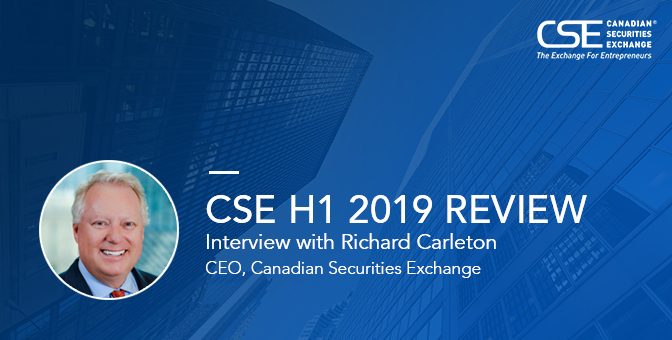When it comes to achieving milestones at the CSE, the Exchange for Entrepreneurs is on an extended winning streak. With capital raised by CSE-listed issuers, trading value, and number of listings (more than 500!) all reaching new heights, it’s already been a strong start to 2019. Scroll on for an exclusive, in-depth interview with CSE CEO Richard Carleton as he discusses the factors contributing to this sustained positive momentum, and provides a glimpse of what’s ahead for the next half of this record-breaking year.
The first half of 2019 saw the CSE continue to grow in terms of total capital raised by issuers, trading value and a new record for the number of companies listed. Can you start by giving us the story behind the strong performance? What is allowing the CSE to consistently grow so quickly compared to other exchanges?
It is a continuation of the trends we saw establish themselves in 2018. There remains strong interest in the cannabis sector, particularly for companies working on opportunities in the United States, and increasingly now in the Caribbean Basin, South America, Europe, the Middle East and Asia. We’ve seen a considerable amount of funds raised in the sector and an increasing pace of mergers and acquisitions activity.
We’ve also seen renewed interest in the mining space. I was looking at our year-to-date numbers the other day and to the end of June, an identical number of mining companies have joined the exchange this year as cannabis issuers. We have also welcomed a significant group of technology companies.
These are very positive trends: the diversification in the makeup of newly listed companies is healthy, and I think the rebound in the mining sector – particularly gold exploration – is something that people are going to be very interested in as the year progresses.
I recently saw comparisons showing the CSE leading other venture-focused exchanges in several categories, including average issuer market capitalization and average financing size. What’s driving these KPIs and is it sustainable?
Again, this is largely a cannabis story. If you look at our most active stocks, they tend to be from the cannabis sector. What it speaks to, in particular, is continued retail interest in the industry. It also speaks to the appeal of the issuer community we have been able to bring to the exchange. It’s a very diverse set of companies, ranging from those involved in cultivation in Canada to multistate operators in the US, and companies looking even further afield internationally.
We are also starting to see issuers with more than just cultivation. Examples would be companies that are looking to make improvements in extraction, others in biotechnology, and yet others building brands in specific markets. These companies, in some cases, trade for $15 or $20 per share, and that positively impacts the value of trading.
Let’s run with that theme. Last year, Curaleaf’s IPO was the biggest the CSE had ever seen, at the equivalent of some CDN$520 million, and Harvest Health & Recreation announced a financing in April of this year equal to around CDN$650 million. Those are just a few examples of financings big enough to fuel sustained national or multinational growth. What are you hearing from issuers regarding who is coming into these deals, and their general experience raising large amounts of capital on the CSE?
What is interesting about these transactions – and you didn’t mention the largest of all, which is the short-form prospectus that Acreage filed with the Ontario Securities Commission recently to raise up to US$800 million – is that they really are global efforts.
We know that Canadian retail and institutions have been long-time supporters, which seems kind of funny to say for an industry that is, at best, five years old. But they continue to be a significant and core part of large financings. And we are increasingly seeing participation from the United States. Family offices, hedge funds, and high net worth individuals are backing these raises. Parsing the information after a financing closes, we also see interest from institutions and family offices in Europe and Asia. When we totaled it up last year, we saw 103 different jurisdictions around the world represented by investors in deals on the CSE. I think on a year-to-date basis it is about 83 jurisdictions represented. Basically, every part of the globe has participated in capital raises conducted through the facilities of the CSE.
Issuers have emphasized to me repeatedly that there are no concerns with the fact that their company is listed on the Canadian Securities Exchange. We are a recognized exchange around the world for a variety of tax and pension investment purposes, and because we have achieved that status our issuers find very little resistance to investment in their transactions because of their listing exchange.
The British Columbia Securities Commission is now one of your official regulators. Explain that development and what it means going forward in practical terms. Will it slow or change things in any way?
The British Columbia Securities Commission has been talking about taking on this role for as long as I have been with the Canadian Securities Exchange, and that’s about 12 years at this point. The reason is that a majority of the companies listed on the CSE are domiciled in British Columbia.
I think the commission moving now is a reflection of our relevance and continued growth in the number of listings. There are now over 250 BC companies that trade on the CSE. With so many connections to the province, I believe the commission concluded that it was in their interest to take an active role in the regulation of the exchange.
Our long-standing principal regulator is the Ontario Securities Commission; the BCSC will be working with the OSC to make sure there are not any duplicative activities. As a result, I am confident that the BCSC move will not impact the operation of the exchange in any way. We have worked very closely with the OSC and BCSC over the years and will continue to do so effectively.
I hear the CSE is planning to introduce a separate tier for senior companies. What is the thinking behind that? What benefits will it offer companies that qualify for this tier?
We find ourselves in a situation unique in Canada. Under the National Instruments that set out how companies and exchanges are regulated, it’s really divided into two worlds: venture exchanges and non-venture exchanges. The rules for companies listed on a venture exchange have a lighter touch than for companies listed on a non-venture exchange, such as the Toronto Stock Exchange. We find ourselves in the fortunate situation of having listed companies that fall into both “venture” and “non-venture” buckets.
We are not proposing any change in the way our early stage companies are regulated. We now have a substantial number of companies that have significant market capitalizations, tangible assets, and revenue coming from a variety of jurisdictions. A regulatory framework designed to oversee the operations of a junior mining exploration company really is not up to the task of overseeing the operations of a US multistate operator in the cannabis industry with a multi-billion-dollar market cap and hundreds of millions of dollars in annual revenue.
We’ve been dealing with this to date by imposing higher standards on these larger companies as they list. So, there has been no regulatory gap, but we are now in the process of introducing changes to our listing rules designed to make these higher standards official and transparent.
When the project is complete, following a process with our regulators and a public comment period, these companies will be separately identified for the information of investors. We expect that the securities of these senior issuers will be eligible for margin under IIROC rules. It will also give the exchange the ability to list special purpose acquisition corporations, which are becoming an increasingly popular vehicle for creating public companies in Canada. It will also enable us to initiate an ETF listing program, which several parties have been very interested in listing on us. It will help address concerns that institutional investors and professional investors in Canada and the US may have had about the opportunity for regulatory arbitrage between the CSE and other exchanges in Canada.
There is a lot of interest among finance industry professionals in the blockchain-based clearing and settlement system the CSE is developing. What can you tell us about your progress?
The first thing to note is that we retained Andrew Grovestine within the past three months. Andrew is an experienced brokerage industry executive and is going to lead our effort to create a settlement and clearing service in Canada based on distributed ledger technology.
Our vision here is not really to emphasize the clearing and settlement service, although it’s certainly a key component of how we believe the future is going to play out. What we are really looking to do is to provide a safe, regulated environment for the listing and trading of tokenized securities. We think this will be of real interest to companies and investors because using these tokenized securities substantially reduces costs for issuers wanting to pay dividends, royalty streams, or other entitlements a company might want to provide its shareholders. By doing it in this way we can cut the cost of capital for issuers and incent the creation of a whole range of new and interesting instruments, whether they are in the form of common equity or debt, or other types of security instruments that will be of interest to both retail and institutional investors.
One of the pieces of that puzzle is the clearing and settlement component, which will make trading more efficient by shortening the clearing and settlement cycle. It will also make the processing of entitlements to shareholders significantly more efficient. But, as I say, the real headline here is that we want to create the best structure for tokenized securities to trade in a regulated environment.
As far as where we are with the project, we are about to initiate third-party testing with the dealer community. We’ve assembled an advisory group of dealers who will help to guide us through the process and they are excited about the opportunities that this initiative could bring to the market.
The CSE has not raised new capital for many years and on the surface would seem to benefit from a stable ownership structure. How does this help you to serve the market?
We’ve been blessed to have patient and supportive principal shareholders over my term as CEO. I’d begin with Urbana Corporation, which is Tom Caldwell’s investment fund. Mr. Caldwell, as you know, is Chairman of the Canadian Securities Exchange. Shortly after Mr. Caldwell led the recapitalization of the company he was joined by Ned Goodman, who served as Vice Chairman for a number of years.
I can’t tell you how much credibility the investments from Mr. Caldwell and Mr. Goodman brought to the organization. I think that the CSE team was always respected in the industry, but there were concerns as to whether we had the resources to stay in the game for the long haul. With the support from Mr. Caldwell and his team and Mr. Goodman’s investment, those concerns were permanently put to rest, and laid the groundwork for the growth we have enjoyed over the last several years.
Mr. Caldwell, in his presentations, talks about Urbana being “patient capital” and that has absolutely been true with us. We have been able to make investments in a variety of aspects of our business, including in trading technology and adding personnel to meet the increased pace of applications in response to the regulatory challenges this posed. We moved into our new premises in First Canadian Place at the end of January and are in the process of building a presentation centre there that will be used to host listed companies for a ceremony on their first day of trading, and also to recognize key milestones our issuers achieve.
While these investments may have been done at the expense of short-term profitability, we are again positioning the exchange to support even higher levels of growth in the future. Our shareholders have been very, very supportive.
It is definitely the spirit at the CSE to always be looking to do things better. What are you doing to keep momentum going in terms of growth and building the brand?
As people who follow our Instagram and Twitter accounts know, we have been racking up the frequent flyer miles over the past couple of years. There is a concerted effort by the team to get out there and tell the story of the Canadian Securities Exchange to influencers, be it lawyers, accountants or investment dealers and bankers. We’ve been doing a lot of work with the community to ensure they understand who we are and what our value proposition is. We also, of course, engage in direct sales work with individual companies that are looking to access the Canadian public capital markets.
That has been a big part of our success over the last few years, but the thing that I think truly sets us apart from most securities exchanges – not just in Canada but around the world – is that we are the only start-up exchange in recent memory that has really had an impact on the local capital market. People see that and see the success we’ve had and understand that it reflects the CSE team’s experience, knowledge and commitment to customer service.
The other thing I attribute it to is the fact that we are entrepreneurs ourselves. I have noted in past interviews how most of the team here has been through the lean times and worked with us through multiple fundraising efforts. We have done exactly the same thing that the entrepreneurs who come to us to list their companies do. We’ve done the investor pitch decks, we’ve signed the NDAs, we’ve done the presentations, we’ve had the door slammed in our face. That gives our team insight into the challenges that an entrepreneur faces as they try to raise money to achieve their business goals. Understanding where they are and knowing that we have been in their proverbial shoes builds an energy around the organization that people sense and really take a high degree of comfort in.
We’re doing all of the other things I mentioned, such as building a presentation centre for listing ceremonies. We built a podcast studio and are releasing podcasts at a furious rate through the various media we use to distribute them. Our initiatives via the Internet and social media are developing a real following.
It’s not any one thing, I think it’s a combination of all those things that gives people the sense that we are on the right track and that this organization is really going places.









